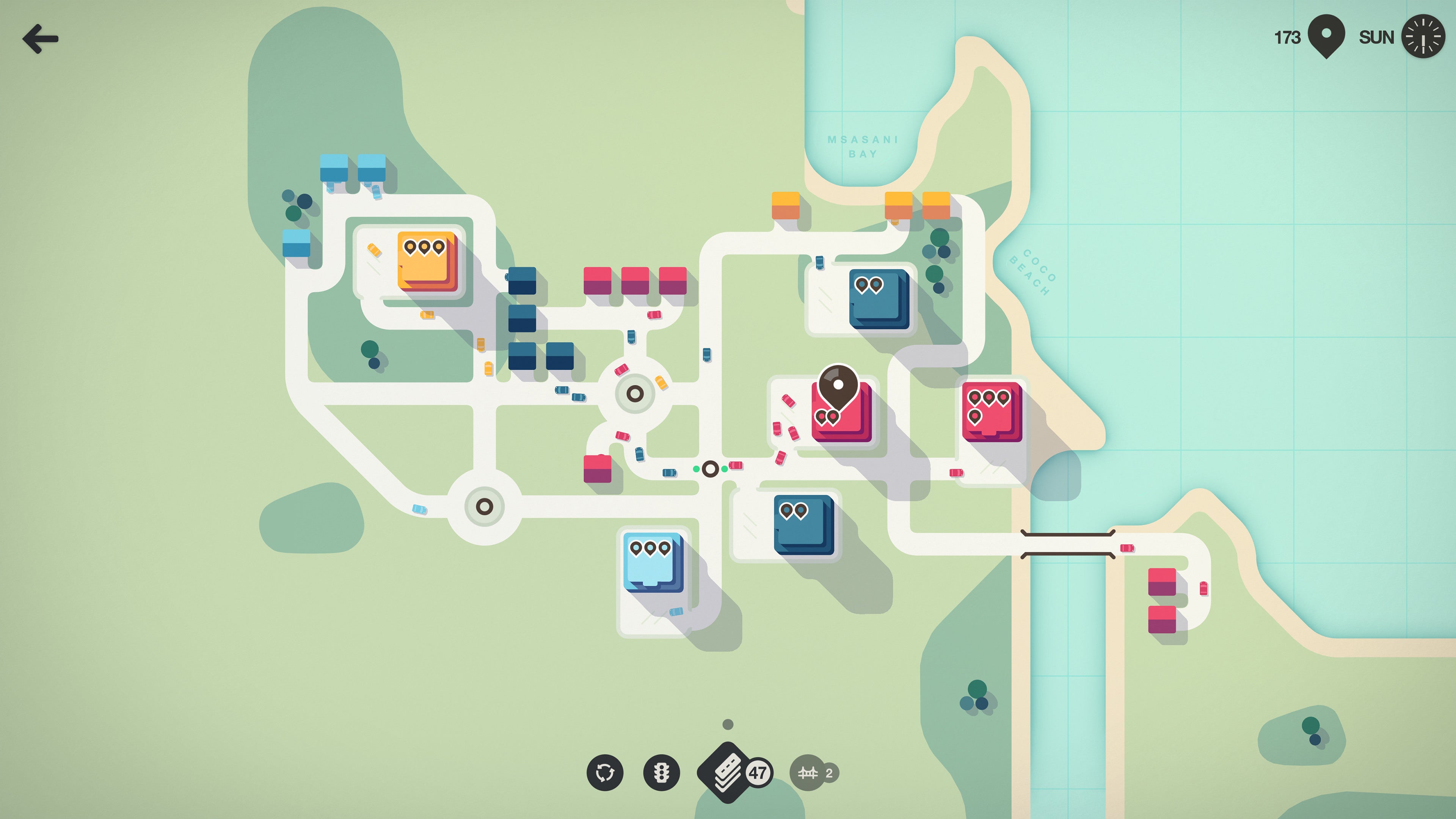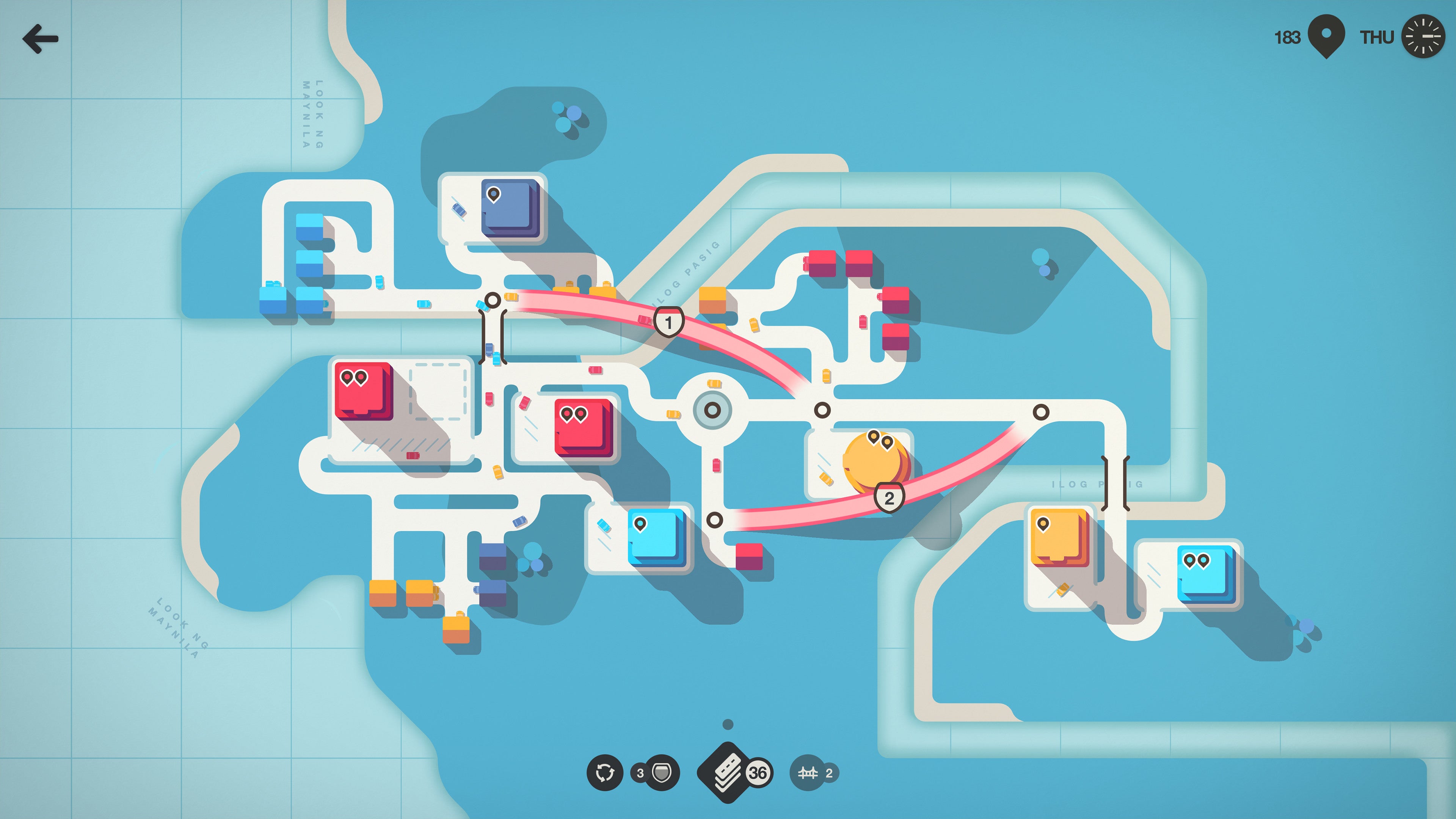This is how Mini Motorways is played. This is a city-building puzzler that may also be one of the most aesthetically refined games ever made: flat colour and pleasing abstractions of the modern world, its concrete and metal, its curtain-walling and internal combustion. You play by connecting businesses of a certain colour to houses of the same colour, without causing traffic jams and snarl ups as houses and businesses of different colours start to appear too. But, really? Really, you play by frowning. Studious frowning: a dense seminar with a new professor, a lengthy but intriguing sentence whose meaning you need to untangle. A tile here. A road there. Frown. Roundabout? Junction? Now I think about it, it’s exactly the frown that chess masters do, delicate chin balanced on delicate fist as they study a refined landscape of total information. But when I play chess I can take my time with my terrible moves. Mini Motorways requires speed-frowning. Every second you spend on one problem only means that the next problem is getting worse somewhere else. Traffic jams ripple through the body of your city like a horrible kind of peristalsis. Your miseries queue here, and double back on themselves. Except they aren’t really miserable at all: they’re energising! Transformative! And coming back to Mini Motorways for State of the Game - not that I am ever, truly, away from Mini Motorways for very long - I see that the game itself has been transforming too. The game my daughter now frets over is not quite the same game that I first played on Apple Arcade, when Apple Arcade was new. Small things. Incremental things. Very Mini Motorways. There are platform changes - you can play on PC and Switch now, which means you can draw paths with one button and delete with another instead of switching between edit and non-edit modes. But also, as the game leaps from one device to the next, its developers add things to the whole package. Mini Motorways grows, as slowly and steadily as one of its own doomed cities. (It’s not alone, incidentally - the same team is still updating its previous game, Mini Metro.) Let me take you through it all. Arrival on Steam brought new cities - Dubai and Mexico City - as well as roundabouts, which after more than a year I am still getting to grips with, still staring into their whirling depths in the hope of understanding how to get the most from them. Then the developers added their home town, Te Whanganui-a-Tara, Aotearoa, “the coolest little capital in the world”. Then each map got its own specific challenge modes. Jeepers. These challenge modes take a game about building a city and throw in electrifying restrictions. Los Angeles with just a single motorway? It should not be allowed. Beijing, where diagonal roads suddenly eat up twice as many tiles? Mexico City with unlimited tunnels, but no other upgrades beyond road tiles? Who created this monster? It’s evil stuff - and it slots in beautifully alongside the daily and weekly challenges. Wonderful evil stuff. Finally, we got headlights added to Night Mode, alongside new cities Warsaw in Poland and the Thai city of Chiang Mai, which, with its Old City Moat, is one of the most challenging cities out there, a bridge-needy puzzle in and of itself. And this is the thing really. That moat - I have tried many different ways of dealing with it, dealing with the way it places a perfect square of water on the map, a square that will require at least four bridges to take care of, if I’m not being careful. Chiang Mai: The Map never changes, but the game is constantly evolving without adding anything. Yes, because businesses and houses spawn in different places each time you play a map, but also because the more I play, the more I frown my way into a deeper, more nuanced understanding of how Mini Motorways works, which really means how cities work, what allows them to thrive and what causes them to whither. After a while it becomes clear that Mini Motorways isn’t about cars at all, but about the communities within cities and how their needs and ambitions are balanced alongside one another. I don’t feel like I’m throttling the world deeper into the Anthropocene with each slab of concrete I lay down, so much as trying to find a more elegant way for city-dwellers to get by. Which is to say: it gets into your brain, this game. And it opens up the world a little - maybe many worlds. And so, one day, I hope, I will look out of the window of a plane and see a landscape below that I know intimately. Not because I have visited and seen the galleries and wandered around the markets, but because I once worked out where to put those sodding roundabouts. This piece is part of our State of the Game series, where we check in on some of the biggest service games running to see how they’re getting on. You can find plenty more pieces like it in our State of the Game hub.


